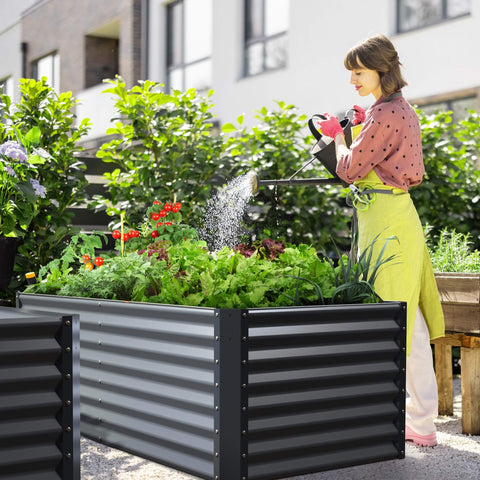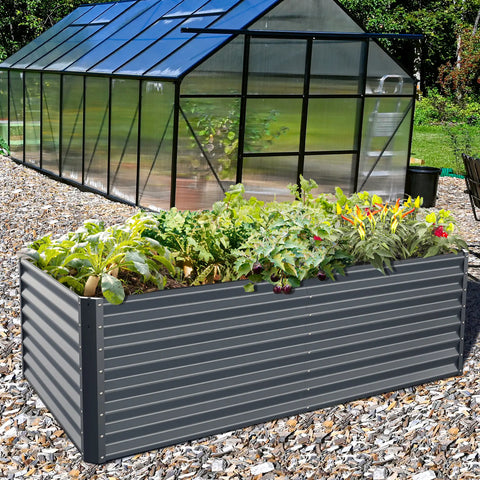Are you going to make a beautiful flower bed in your backyard? If this is the case, choosing the right material is important not only for the durability of your structure, but also for the health and safety of your plants.
With countless options on the market, it's important that you choose safe and sustainable materials that don't leach harmful chemicals into the soil or affect plant growth. You can even embark on DIY playground projects to further improve your outdoor space.
In this article, we will guide you through the safest materials to use when building a raised garden bed. We will discuss the benefits of using these safe materials and outline which materials should be avoided. In addition, we will provide tips on how to build a safe and lasting flower bed while taking into account environmental impact and aesthetics.

What material is safe for a garden bed?
Raised garden beds can be built with a wide variety of materials, but safety should be a priority as these will be used to grow food. Here are some safe materials to use:
Untreated wood: Cedar and redwood are popular choices because they are naturally rot - and insect-resistant, and they don't require chemical treatments that could potentially harm plants.
Composite wood: This is a type of wood made from recyclable materials such as sawdust and plastic bags. Composite wood is more resistant to rot and more durable than natural wood.
Concrete blocks or bricks: These building materials can be arranged to form the walls of your elevated bed. They are safe, strong and durable.
Stone: Natural stone can be an aesthetically pleasing, durable, and safe choice for a raised bed.
Galvanized steel: Galvanized steel is another option. It's durable, and the zinc coating prevents rust.
Recycled plastic: This is a good, durable option. However, make sure that the plastic is safe and does not contain harmful chemicals such as bisphenol a.
Remember, the key is to find the perfect garden bed material that has been treated with harmful chemicals, as these can leach into the soil and harm your plants. No matter what material you choose, it's also a good idea to line the inside of the bed with a layer of landscape fabric to keep the soil in place and prevent weeds from growing. Be sure to do your homework before choosing materials to build a raised bed.
What are the benefits of using safe materials to grow garden beds?
Plant health: Safe materials ensure that your plants are not exposed to harmful chemicals or toxic substances that may be absorbed by the soil and then by the plants. This is especially important when growing food crops, as toxins end up in your food.
Bed life: Safe, durable materials that can withstand environmental stress ensure the life of your bed. Untreated cedar and redwood, for example, are naturally resistant to rot and insects, which can extend the life of your garden bed.
Sustainability: Using environmentally safe materials can have a positive impact on the environment. For example, recycled plastic reduces waste that would otherwise go to landfill, while providing a durable, long-lasting material to build raised beds.
Soil quality: Safe materials, such as natural wood or stone, can promote a more balanced soil ecosystem by not introducing harmful substances. This helps promote a healthy environment for microbes that are critical to soil health and plant growth.
Human health: Especially when growing food, the use of safe materials is essential for human health. If toxic substances seep into the soil, they can be absorbed by plants and possibly ingested by people, causing health risks.
Wildlife and pet safety: Some materials used in garden beds can be harmful to pets and wildlife if ingested. Using safe materials can reduce this risk and make your garden a haven for local biodiversity.
When choosing materials for your garden beds, consider where they came from, how they were treated or manufactured, and their impact on your garden and the wider environment.

What materials should be avoided when building garden beds?
When building raised garden beds, certain materials can be problematic. They can either affect the health of plants or have a negative impact on the environment. Here are some materials you should avoid:
Treated wood: Treated wood contains chemicals, such as arsenic, that can leach into the soil and potentially be absorbed by plants. These chemicals can also harm beneficial soil organisms. If you are not sure whether the wood has been treated, it is best to err on the side of caution and avoid using it.
Railroad ties: Similar to treated wood, railroad ties often contain creosote, a toxic chemical used as a wood preservative. It is harmful to both plants and people and is generally not recommended for use in home gardens.
Painted or stained wood: Unless you are certain that the paint or stain is non-toxic and safe to use in the garden, it is best to avoid painted or stained wood. Many paints and stains contain harmful chemicals that can leach into the soil.
Pallet wood: While using pallet wood may seem like a good recycling idea, it can be risky because you often don't know what's being transported on the pallets, and they may have been treated with harmful chemicals.
Certain plastics: Some plastic materials can leach out harmful chemicals, especially in sunlight. For example, avoid polyvinyl chloride, which can leach out harmful phthalates. If you choose plastic, use food-grade or UV-resistant plastic.
When building a garden bed, knowing the history of the material is crucial, especially if you plan to grow food crops. Choose raw, natural, and safe materials whenever possible.
How to build a safe garden bed?
Building a safe garden bed requires careful selection of materials, ensuring proper construction, avoiding the use of harmful substances, and taking steps to protect the bed from pests and environmental conditions. Here's a basic step-by-step guide:
Plan your bed: Decide on the size of your garden bed. A common size is 4x8 feet; This allows you to reach into the bed easily from both sides. The height depends on your preference, but 1-2 feet is common. Remember, beds must be filled with soil, so taller beds require more soil.
Cutting and assembly: The material is cut to the desired size (if not pre-cut). Use it to form a rectangle (or square) with the end of the longer film facing the end of the shorter film. Use corner brackets and screws to secure the parts to the corners. Make sure your structure is horizontal and square.
Place to prepare: Choose a sunny spot (6-8 hours a day is ideal for most vegetables). Remove all grass or weeds from the site and level the ground as much as possible.
Lay out a weed cloth: Lay out a weed cloth or landscape cloth to cover the area where your bed is. This helps prevent weeds from growing into the garden bed.
Place the bed: Place the assembled garden bed on the fabric. You can staple the fabric to the bottom of the bed to keep it in place, or when you've filled the bed, you can tuck it under the soil.
Fill your bed with a mixture of topsoil, compost, and other organic material to create a rich, well-drained garden soil. You can buy pre-mixed bed soil or mix it yourself.
Plant Your garden: Now you're ready to plant! Whatever plant you choose, make sure you follow specific planting instructions.

What are some examples of safe and sustainable materials used to grow garden beds?
Elevated garden beds can be constructed from a variety of safe and sustainable materials. Cedar or redwood are two good wood choices because they are naturally rot resistant and do not leach harmful chemicals into the soil. Using recycled wood is also a sustainable option, but one must ensure that it has not been treated with toxic preservatives.
Recycled plastics or composite wood offer durable and weather-resistant alternatives, although they may not be as aesthetically pleasing as wood. Stone or brick can provide longevity and a classic look, but sourcing and transporting these materials can have an impact on the environment.
Finally, corrugated metal can create modern, durable raised beds that effectively maintain soil temperature. Our metal garden beds are one such option, both beautiful and durable. Regardless of the material, it's important to consider its life cycle, potential impact on soil health, and durability in outdoor conditions.
Make garden beds from the best building materials
Using the best nursery materials is essential for a successful vegetable garden. Take the time to research which materials are safe to use over the long term so you can build an attractive, functional space that can be enjoyed for years to come.
In fact, the right bed can help extend your growing season, so be sure to choose the best material for your needs.
With proper research and careful selection of materials, you can create a garden bed that will last for years to come. Not only does it give you a place to grow food crops; It will also keep them safe from pests and other environmental threats. With these tips in mind, you can create beautiful, productive raised beds.









